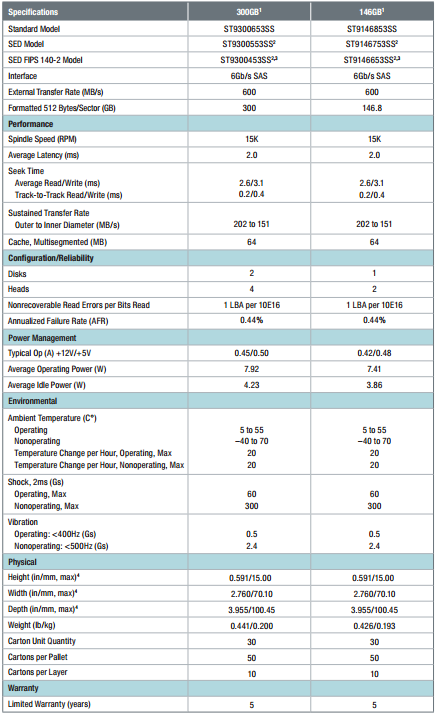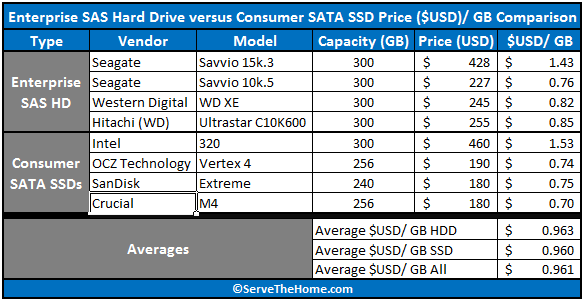I had not thought about this in awhile, but Solid State Drives (SSDs) are now less expensive than their hard drive counterparts. Sure, someone probably just did a bit of research and saw a SanDisk Extreme 240GB is $180 ($0.75/GB) while a 3TB Western Digital Red edition drive is $180 ($0.06/GB) and declared me insane. I would instead argue that a SSD is not competing with a slow as can be massive 3TB drive. Instead, we should be comparing the current crop of solid state drives to their spindle counterparts, 10K and 15K rpm SAS drives. Of course, one could add a 300GB Velociraptor in there to showcase fast spinning SATA drives and the result would be similar.
Just to make this more interesting, I am also going to omit power consumption. Even a power hungry SSD like the OCZ Vertex 4 256GB consumes around 4w while according to the Seagate Savvio 15k.3 spec sheet, fast spindle drives can consume over 8w under load. Note the specs below state 7.92w as the average load power and an average idle power at idle around what a power hungry SSD will pull at load. While this may not seem like a lot, in larger 24 drive arrays, adding 4w per drive is 96w or just about enough to cost $20/ mo for another 1A @ 120v feed in a data center after power supply inefficiencies. I digress, we cannot consider this, only $/GB.

After throwing performance out, as well as power consumption out, we are now down to price per GB on “performance” drives. I decided to pick a few examples in mid-July 2012 just to see what I could find in the 200-300GB segment. Moving well beyond the 500GB capacity, platter drives still do really well since the incremental cost of adding additional platter media is relatively low compared to NAND cost in a SSD’s bill of materials. Here are the competitors:
Traditional Enterprise 2.5″ Hard Drives
For the 2.5″ traditional enterprise category, I picked single ported versions of drives from Seagate, Western Digital and Hitachi (now Western Digital.) For those wondering, Seagate and Hitachi have traditionally dominated the enterprise drive market.
- Seagate Savvio 15k.3 300GB – 15K rpm 2.5″ SAS
- Seagate Savvio 10k.5 300GB – 10K rpm 2.5″ SAS
- Western Digital WD XE WD3001BKHG 300GB – 10K rpm 2.5″ SAS
- Hitachi (Now Western Digital) Ultrastar C10K600 300GB – 10K rpm 2.5″ SAS
For those wondering, I did not include disks like the C10K900 series (which is a lot more expensive) since it has built-in encryption. Drives with encryption tend to cost a lot more so I purposefully left those out. I also left out the newest generation 10,500 rpm Toshiba AL13SEB900 drives because those are not yet widely available in the channel.
Solid State Drives
I decided to pick four solid state drives that are all slightly different. I would have added the Samsung 830 256GB SSD but that would have skewed the figures clearly in favor of the solid state lineup.
- Intel 320 300GB – 3.0gbps SATA but a server favorite with capacitors to stop data loss and massive endurance/ performance gains from over-provisioning free space.
- OCZ Vertex 4 256GB – 6.0gbps SATA Marvell controller with Indilinx Firmware.
- Crucial M4 256GB – 6.0gbps SATA Marvell controller.
- Sandisk Ultra Extreme 256GB – 6.0gbps SATA with a LSI – SandForce controller and Toggle NAND.
This was a fairly close competition for inclusion primarily because there are more companies with SSD controllers in the consumer market (Intel, Samsung, Marvell, LSI SandForce, Phision, Toshiba, and OCZ) than there are hard drive manufacturers. Add to this that many of the vendors sell their SSD controller technology to other vendors (e.g. Marvell and LSI SandForce to Intel) and to OEM partners (Corsair, OCZ Technology, SanDisk and other) and picking four drives is difficult. I left the Intel 320 in the mix because it did bring up average price a lo for the SSD camp as will be seen shortly.
The Comparison
Comparing enterprise disk prices with SSD prices was actually quite difficult. Enterprise SAS drives tend not to go on special very often. Also, purchasing a HP drive for example will usually cost more at retail than buying the original Seagate or Hitachi alternative. With the competition lined up, here is a quick spreadsheet with the comparison of street pricing I pulled this week:

As one can see, the numbers do come out slightly in favor of the SSD camp as I am writing this the week of 16 July 2012. It is an ever so slight advantage for SSDs but one can now support the notion that they are reaching parity and starting to become less expensive than enterprise SAS hard drives. Also, there is a lot more variability in SSD pricing especially for ones sold through the channel to the SMB and consumer segments. This is going to vary week by week for the next month or so but at the rate prices are falling it will likely be the norm by next quarter.
The Catch – Enterprise Hard Drives are Still Less Expensive than SSDs
Personally, the last six solid state drives I have purchased were between 240GB and 256GB in size. As prices have fallen, that has become a sweet spot. When we look at a SSD bill of materials (BOM) the PCB and housing are not exceedingly expensive. Most of the money is going for the controller and NAND. Generally, adding more NAND does not require additional RAM a more expensive PCB or a different controller so scaling from 128GB to 512GB is a matter of how much flash is added to the PCB. Part of the drive cost also goes to cover profit and sales, general and administrative (SG&A) costs but realistically SG&A should be fairly similar between drive capacities so we are again looking at NAND costs.
Why this matters is because it costs significantly more to add 256GB of flash memory to a SSD than it does to add an additional 300GB platter and associated mechanics to a traditional enterprise drive. Moving up to the next capacity size with 512GB of flash or 600GB of spinning disk starts to show that SSDs do not scale as well. The Intel 320 SSD at 600GB costs almost $900 these days. Intel is likely to drop SSD pricing soon (and may have by the time this is published) which is good, but it is fairly clear that larger platter drives are poised to stay less expensive in the near term.
Conclusion
For years, we have continuously heard that solid state disks offer massive performance gains over their spindled counterparts. In practice, this is getting closer to the flipping point. Looking at high-end enterprise disks and comparing them to prosumer SATA drives is also not exactly fair as something like a SanDisk Pliant SSD or a STEC ZEUS MAX IOPS is likely to be more reliable, faster and much more expensive. With that being said, there are many use cases today where using less expensive commodity parts is becoming commonplace. We are at the point where it is still a matter of the quantity and magnitude of solid state drive promotions on a given day that drive Synchronous or Toggle NAND SATA SSD pricing below that of 2.5″ 10K or 15K rpm enterprise hard drives. At the current rate of decline, this is either going to either be the norm or will cause the big drive makers to drop prices accordingly. For those that think this is a completely foolish thought that SATA SSDs can replace enterprise hard drives, you might want to read the Innovator’s Dilemma which actually uses the storage industry extensively for examples. For the time being high-capacity 3.5″ storage is safe, but I have countless folks that did not know what a SSD was twelve months ago come to me raving about their Apple Macbook’s performance with a SSD. That tells me that Apple is much better at marketing than I am at explaining the benefits of solid state storage. It also tells me that the mass market is taking notice.
P.S. If one were to go back to September 2009 on the site’s twelfth post, I discussed my thoughts about using an Adaptec 5805 RAID controller with eight Seagate Savvio 15k.1 rpm drives in RAID 5 versus an original OCZ Vertex with the Indilinx controller. Back then a 256GB drive was $725 as I noted in the article’s text. Today that same $725 would get you almost four times the capacity and four times the performance.




Uber analysis. I think SSD prices are higher than SAS drive this week but I also remember the Sandisk Extreme being 160usd recently not 180.
I get what you did and it makes sense. Do you then compare 3TB drives to asynchrounous SSD? That will take awhile but the comparison to SAS makes sense.
did the calcs on my own. thought you just averaged the $/gb but you did the correct math since the ssds were all differing sizes. kudos.
WDC, STX and Toshiba are in trouble. I read that book recently. Same thing.
Patrick:
I always enjoy reading your posts with a wide variety of subjects about Servers. Keep it up we like it.
2012 12 27: a 1 TB SSD is anywhere between $999 and $2500. A 2 TB HD (twice the capacity) is $100. I’m not a mathematician, but I fail to see how SSD is close to let alone cheaper than a hard drive.
You are not comparing performance SAS hard drives to SSDs. Cheap hard disk storage is not competing against SSDs, SAS drives are.
Thank you for an informative article. For me, on my home computer, I want reliability. The first spec I look at is mtbf, then speed, then size, and then price. The SSDs have driven down all storage prices but I still don’t trust their reliability. When I can purchase a 4TB WD Gold drive with 2.5million hour mtbf for a little over $200 it makes no sense to me to even consider an SSD. I simply cannot afford the extra cost of unreliable drives.
Hi Bob – we have been keeping tabs on SSD reliability: https://www.servethehome.com/used-enterprise-ssds-dissecting-our-production-ssd-population/
Hard drives are 10-20x more likely to fail than SSDs.